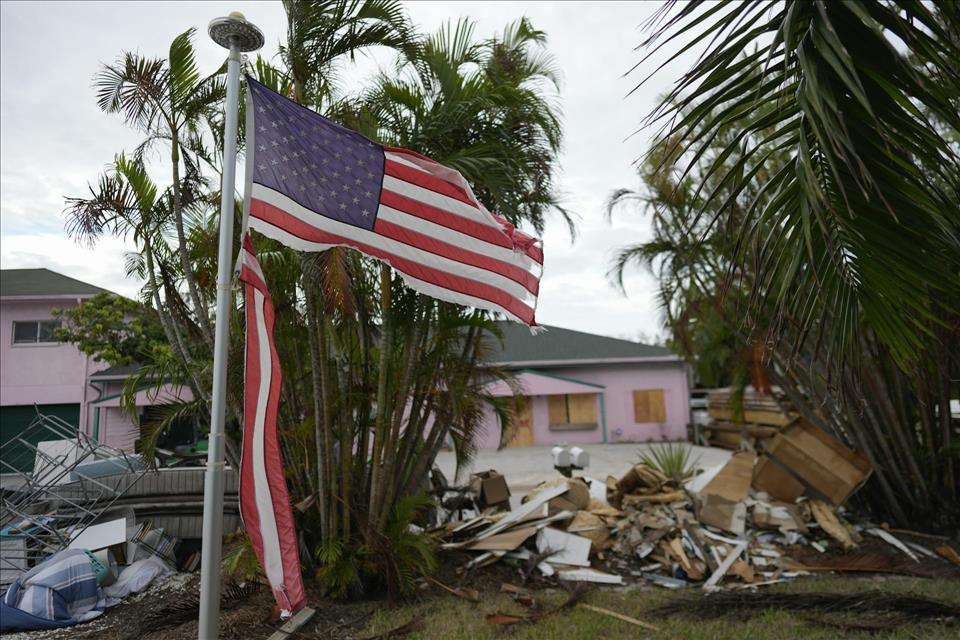
Trump's Plan To Eliminate FEMA Is A Very Bad Idea
In contrast, a bombastic President Donald Trump used his first domestic trip on Jan. 24 to tour disaster sites in North Carolina and Los Angeles while promoting his litany of grievances and rambling about his dislike of the Federal Emergency Management Agency (FEMA).
It takes a perverse set of skills for a president to act in a way that squanders the opportunity to genuinely exhibit compassion for disaster victims while also lowering the morale of emergency workers at the same time.
Trump's announcement to overhaul or eliminate FEMA - especially in the midst of an ongoing disaster - is unreasonable and foolish.
Firefighters working to fight the Palisades fire in Malibu, Calif. on Jan. 8, 2025. (AP Photo/Etienne Laurent, File) Trump's criticisms
In a Fox News interview on Jan. 22, Trump suggested that FEMA would be facing a reckoning.
The president echoed Republican criticisms of the Hurricane Helene disaster response last September. During Hurricane Helene, Trump has used his bully pulpit to endorse or invent false or unsubstantiated claims . The federal government was also falsely accused of a lack of response following Helene.
While touring hurricane damage in North Carolina on Jan. 24, Trump remarked:
Trump indicated he would like to see state governments respond to disasters .
The White House later clarified that an upcoming executive order would direct a council of FEMA advisers to examine the agency and come up with proposals for reform.
FEMA's search and rescue team member works in a residential area consumed by a wildfire in Lahaina, Hawaii, on Aug. 18, 2023. (AP Photo/Jae C. Hong) Turning back the clock
If Trump gets rid of FEMA, he'll be turning back the clock 50 years. It is illogical to call for a return to a time with a weak and disorganized system of disaster management.
In the 1970s, states were responsible for managing their own disasters. More than 100 different federal agencies could become involved in relief efforts. The system was reactionary and responded on a need basis, with no clear pathways for federal disaster assistance to states.
State governors became increasingly concerned about the lack of a comprehensive national emergency policy. The dispersion of federal disaster management responsibilities among numerous federal agencies was viewed as impeding states' own ability to manage disaster situations.
In advocating for better disaster management, a National Association of Governors' report entitled 1978 Emergency Preparedness Project made the case for a centralized emergency management system in the U.S.
President Jimmy Carter acted on the recommendations of the governors with Executive Order 12127 to create FEMA in 1979. It was a cabinet-level agency until 2003, when it was merged into the Department of Homeland Security .
Read more: Jimmy Carter's death invites us to consider his legacy of nuclear emergency response and disaster management
Duties enshrined in lawWhen a large-scale disaster stretches the ability of an American city to help its citizens, a formal process exists to request aid. As a local disaster expands in size and scope, requests for more assistance can go up to higher levels of administration, from the state governor and ultimately to the president. In this process, FEMA reports to local governments .
A presidential disaster declaration can open up access to an array of federal programs managed by FEMA to assist with response and recovery .
FEMA was created by President Jimmy Carter in 1979. (J. Rozdilsky), CC BY
The role of FEMA in supporting the declaration process are defined in provisions in the U.S. Code of Federal Regulations . The Stafford Act also provides for the statutory authority guiding FEMA programs like individual assistance .
While Trump sits at the top of the executive branch, he can engage in a variety of political shenanigans to undermine FEMA, but he cannot unilaterally abolish the agency . As the agency's duties are enshrined in law, only an act of the legislative branch can terminate FEMA.
A turbulent historyFEMA has existed for 46 years and faced turbulent times due to the poor decision-making by past Republican presidents. In 1980, Reagan appointed agency directors with conservative philosophies who emphasized downsizing. Under George W. Bush's presidency, among the flurry of reactions to Sept. 11, 2001, FEMA was eviscerated and relegated from a top-level cabinet level agency to a position buried deep in the Homeland Security organizational chart.
Trump's aggressive posture in trying to remake government involves creating diversions, sowing chaos and overloading people with lies. Taking a cue from his former White House strategist Steve Bannon on how to deal with the media, Trump's statements about FEMA have worked to“flood the zone with shit .”
As with many functions of American government, emergency management is just the latest target of disorientation tactics intended to paralyze government operations.

Legal Disclaimer:
MENAFN provides the information “as is” without warranty of any kind. We do not accept any responsibility or liability for the accuracy, content, images, videos, licenses, completeness, legality, or reliability of the information contained in this article. If you have any complaints or copyright issues related to this article, kindly contact the provider above.






















Comments
No comment